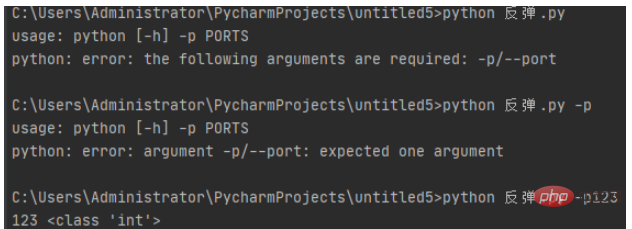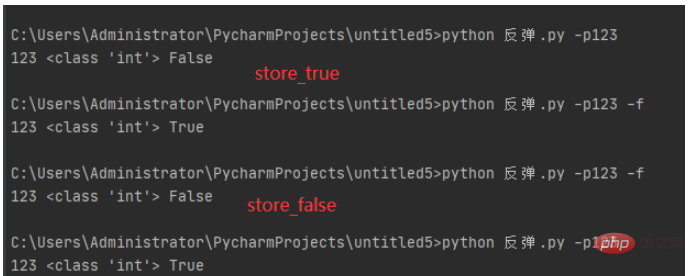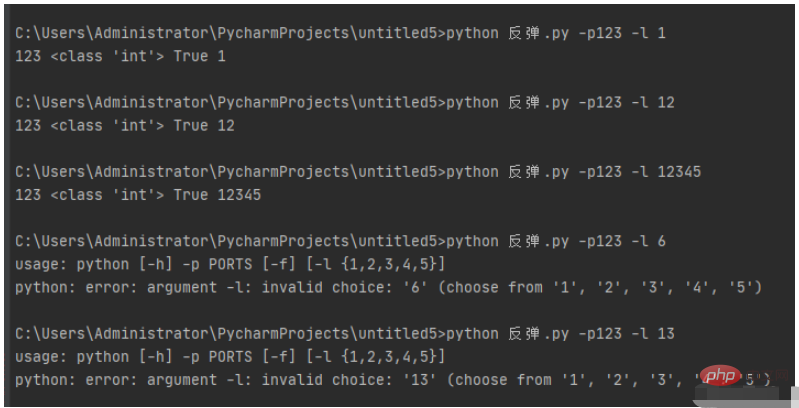How to use python command line parameter module argparse
The argparse module in Python is a command line argument parser that allows developers to easily write user-friendly command line interfaces.
The argparse module can automatically parse parameters from the command line, convert them into objects in Python, and provide some additional functions, such as automatically generating help documents, parameter type checking, etc.
The core of the argparse module is the ArgumentParser class. You can use this class to define the parameters and options that the program needs to receive.
Four steps to use argparse
Import the argparse package— —import argparse
Create ArgumentParser() object
Call the add_argument() method to add parameters
Parse command line parameters——Use parse_args() to parse the added parameters
Parameters of method add_argument:
def add_argument(self,
*name_or_flags: str,
action: Union[str, Type[Action]] = ...,
nargs: Union[int, str] = ...,
const: Any = ...,
default: Any = ...,
type: Union[(str) -> _T, (str) -> _T, FileType] = ...,
choices: Iterable[_T] = ...,
required: bool = ...,
help: Optional[str] = ...,
metavar: Union[str, Tuple[str, ...], None] = ...,
dest: Optional[str] = ...,
version: str = ...,
**kwargs: Any) -> ActionExample
parser=argparse.ArgumentParser("python")
parser.add_argument("-p", "--port",help="port to listen",type=int,nargs=5,dest="ports")
args=parser.parse_args()
print(args.ports,type(args.ports))
Explanation:
-p,–port, parameter name, help: Help information, type: the type of parameter being converted, nargs: read the number of command line parameters, multiple parameters are converted into a list, dest: the parsed parameter name
parser.add_argument("-p", "--port",help="port to listen",default=8080,type=int,dest="ports")
args=parser.parse_args()
print(args.ports,type(args.ports))default: default value

parser.add_argument("-p", "--port",help="port to listen",required=True,type=int,dest="ports")required: Whether it is a required parameter or an optional parameter

parser=argparse.ArgumentParser("python")
parser.add_argument("-p", "--port",help="port to listen",required=True,type=int,dest="ports")
parser.add_argument("-f","--flags",action="store_true")
args=parser.parse_args()
print(args.ports,type(args.ports),args.flags)action: When with store_true, you pass in Corresponding parameter, the parameter is true, otherwise it is false, and the opposite is true for store_flase

parser.add_argument("-l",choices="12345")
choices,参数l的取值只能是12345,1,2,3,4,5,12,123,1234等,不能是其它,不能乱序
The above is the detailed content of How to use python command line parameter module argparse. For more information, please follow other related articles on the PHP Chinese website!

Hot AI Tools

Undresser.AI Undress
AI-powered app for creating realistic nude photos

AI Clothes Remover
Online AI tool for removing clothes from photos.

Undress AI Tool
Undress images for free

Clothoff.io
AI clothes remover

Video Face Swap
Swap faces in any video effortlessly with our completely free AI face swap tool!

Hot Article

Hot Tools

Notepad++7.3.1
Easy-to-use and free code editor

SublimeText3 Chinese version
Chinese version, very easy to use

Zend Studio 13.0.1
Powerful PHP integrated development environment

Dreamweaver CS6
Visual web development tools

SublimeText3 Mac version
God-level code editing software (SublimeText3)

Hot Topics
 1662
1662
 14
14
 1418
1418
 52
52
 1311
1311
 25
25
 1261
1261
 29
29
 1234
1234
 24
24
 PHP and Python: Different Paradigms Explained
Apr 18, 2025 am 12:26 AM
PHP and Python: Different Paradigms Explained
Apr 18, 2025 am 12:26 AM
PHP is mainly procedural programming, but also supports object-oriented programming (OOP); Python supports a variety of paradigms, including OOP, functional and procedural programming. PHP is suitable for web development, and Python is suitable for a variety of applications such as data analysis and machine learning.
 Choosing Between PHP and Python: A Guide
Apr 18, 2025 am 12:24 AM
Choosing Between PHP and Python: A Guide
Apr 18, 2025 am 12:24 AM
PHP is suitable for web development and rapid prototyping, and Python is suitable for data science and machine learning. 1.PHP is used for dynamic web development, with simple syntax and suitable for rapid development. 2. Python has concise syntax, is suitable for multiple fields, and has a strong library ecosystem.
 PHP and Python: A Deep Dive into Their History
Apr 18, 2025 am 12:25 AM
PHP and Python: A Deep Dive into Their History
Apr 18, 2025 am 12:25 AM
PHP originated in 1994 and was developed by RasmusLerdorf. It was originally used to track website visitors and gradually evolved into a server-side scripting language and was widely used in web development. Python was developed by Guidovan Rossum in the late 1980s and was first released in 1991. It emphasizes code readability and simplicity, and is suitable for scientific computing, data analysis and other fields.
 Python vs. JavaScript: The Learning Curve and Ease of Use
Apr 16, 2025 am 12:12 AM
Python vs. JavaScript: The Learning Curve and Ease of Use
Apr 16, 2025 am 12:12 AM
Python is more suitable for beginners, with a smooth learning curve and concise syntax; JavaScript is suitable for front-end development, with a steep learning curve and flexible syntax. 1. Python syntax is intuitive and suitable for data science and back-end development. 2. JavaScript is flexible and widely used in front-end and server-side programming.
 How to run sublime code python
Apr 16, 2025 am 08:48 AM
How to run sublime code python
Apr 16, 2025 am 08:48 AM
To run Python code in Sublime Text, you need to install the Python plug-in first, then create a .py file and write the code, and finally press Ctrl B to run the code, and the output will be displayed in the console.
 Where to write code in vscode
Apr 15, 2025 pm 09:54 PM
Where to write code in vscode
Apr 15, 2025 pm 09:54 PM
Writing code in Visual Studio Code (VSCode) is simple and easy to use. Just install VSCode, create a project, select a language, create a file, write code, save and run it. The advantages of VSCode include cross-platform, free and open source, powerful features, rich extensions, and lightweight and fast.
 Can visual studio code be used in python
Apr 15, 2025 pm 08:18 PM
Can visual studio code be used in python
Apr 15, 2025 pm 08:18 PM
VS Code can be used to write Python and provides many features that make it an ideal tool for developing Python applications. It allows users to: install Python extensions to get functions such as code completion, syntax highlighting, and debugging. Use the debugger to track code step by step, find and fix errors. Integrate Git for version control. Use code formatting tools to maintain code consistency. Use the Linting tool to spot potential problems ahead of time.
 How to run python with notepad
Apr 16, 2025 pm 07:33 PM
How to run python with notepad
Apr 16, 2025 pm 07:33 PM
Running Python code in Notepad requires the Python executable and NppExec plug-in to be installed. After installing Python and adding PATH to it, configure the command "python" and the parameter "{CURRENT_DIRECTORY}{FILE_NAME}" in the NppExec plug-in to run Python code in Notepad through the shortcut key "F6".




